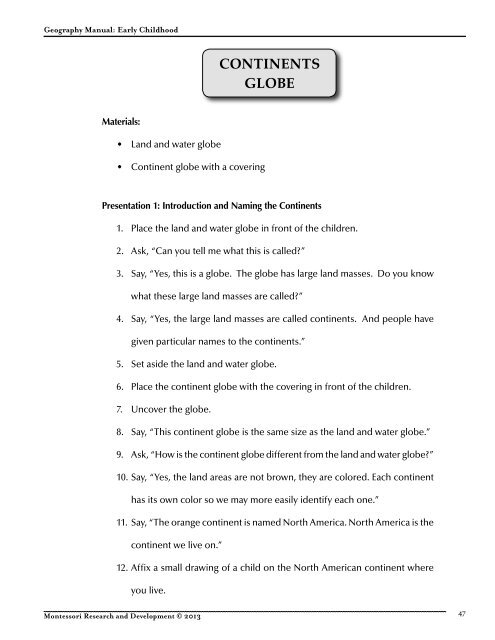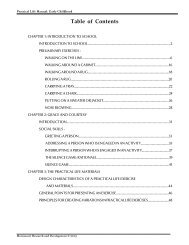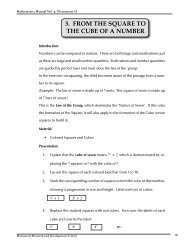View Sample Pages in PDF - Montessori Research and Development
View Sample Pages in PDF - Montessori Research and Development
View Sample Pages in PDF - Montessori Research and Development
Create successful ePaper yourself
Turn your PDF publications into a flip-book with our unique Google optimized e-Paper software.
Geography Manual: Early Childhood<br />
CONTINENTS<br />
GLOBE<br />
Materials:<br />
L<strong>and</strong> <strong>and</strong> water globe<br />
Cont<strong>in</strong>ent globe with a cover<strong>in</strong>g<br />
Presentation 1: Introduction <strong>and</strong> Nam<strong>in</strong>g the Cont<strong>in</strong>ents<br />
1. Place the l<strong>and</strong> <strong>and</strong> water globe <strong>in</strong> front of the children.<br />
2. Ask, “Can you tell me what this is called?”<br />
3. Say, “Yes, this is a globe. The globe has large l<strong>and</strong> masses. Do you know<br />
what these large l<strong>and</strong> masses are called?”<br />
4. Say, “Yes, the large l<strong>and</strong> masses are called cont<strong>in</strong>ents. And people have<br />
given particular names to the cont<strong>in</strong>ents.”<br />
5. Set aside the l<strong>and</strong> <strong>and</strong> water globe.<br />
6. Place the cont<strong>in</strong>ent globe with the cover<strong>in</strong>g <strong>in</strong> front of the children.<br />
7. Uncover the globe.<br />
8. Say, “This cont<strong>in</strong>ent globe is the same size as the l<strong>and</strong> <strong>and</strong> water globe.”<br />
9. Ask, “How is the cont<strong>in</strong>ent globe different from the l<strong>and</strong> <strong>and</strong> water globe?”<br />
10. Say, “Yes, the l<strong>and</strong> areas are not brown, they are colored. Each cont<strong>in</strong>ent<br />
has its own color so we may more easily identify each one.”<br />
11. Say, “The orange cont<strong>in</strong>ent is named North America. North America is the<br />
cont<strong>in</strong>ent we live on.”<br />
12. Affix a small draw<strong>in</strong>g of a child on the North American cont<strong>in</strong>ent where<br />
you live.<br />
<strong>Montessori</strong> <strong>Research</strong> <strong>and</strong> <strong>Development</strong> © 2013 47
Geography Manual: Early Childhood<br />
NOTE: If you live <strong>in</strong> South America, beg<strong>in</strong> with the South American cont<strong>in</strong>ent.<br />
13. Say, “The p<strong>in</strong>k cont<strong>in</strong>ent is just below North America, <strong>and</strong> it is called South<br />
America.”<br />
14. Say, “And across from South America is Africa, which is pa<strong>in</strong>ted green on<br />
this globe.”<br />
15. Say, “Raise your h<strong>and</strong> if you can po<strong>in</strong>t to Africa.”<br />
16. Cont<strong>in</strong>ue with the second period of the three period lesson <strong>in</strong> this manner.<br />
17. Po<strong>in</strong>t to North America <strong>and</strong> ask, “What cont<strong>in</strong>ent is this?”<br />
18. Cont<strong>in</strong>ue with South America <strong>and</strong> Africa, ask<strong>in</strong>g the children to identify<br />
the cont<strong>in</strong>ents.<br />
Presentation 2: Cont<strong>in</strong>uation of Nam<strong>in</strong>g the Cont<strong>in</strong>ents<br />
1. Ask, “Do you know the name of the orange cont<strong>in</strong>ent?”<br />
2. Say, “Yes, this cont<strong>in</strong>ent is North America.”<br />
3. Ask, “Do you know the name of the p<strong>in</strong>k cont<strong>in</strong>ent?”<br />
4. Say, “Yes, this cont<strong>in</strong>ent is South America.”<br />
5. Ask, “Do you know the name of the green cont<strong>in</strong>ent?”<br />
6. Say, “Yes, this cont<strong>in</strong>ent is Africa.”<br />
7. Say, “Just above Africa is a very large cont<strong>in</strong>ent. Because the people that<br />
live <strong>in</strong> one part of the cont<strong>in</strong>ent have a very different culture <strong>and</strong> history<br />
than the people that live <strong>in</strong> the other part of the cont<strong>in</strong>ent, we have divided<br />
this one large l<strong>and</strong> mass <strong>in</strong>to two sections. The red part we call Europe;<br />
the yellow part we call Asia.”<br />
<strong>Montessori</strong> <strong>Research</strong> <strong>and</strong> <strong>Development</strong> © 2013 48
Geography Manual: Early Childhood<br />
8. Say, “A little further over is a brown cont<strong>in</strong>ent called Australia. Actually,<br />
all the isl<strong>and</strong>s, large <strong>and</strong> small, <strong>in</strong> this area are now called ‘Oceania’, which<br />
is the name of the cont<strong>in</strong>ent. At the very bottom is the white cont<strong>in</strong>ent<br />
called Antarctica.”<br />
9. Ask, “Who can po<strong>in</strong>t to Antarctica?”<br />
10. Cont<strong>in</strong>ue with the second period of the three period lesson <strong>in</strong> this manner<br />
with Europe, Asia, <strong>and</strong> Australia or Oceania.<br />
11. Po<strong>in</strong>t to Europe <strong>and</strong> ask, “What cont<strong>in</strong>ent is this?”<br />
12. Cont<strong>in</strong>ue with Asia, Australia or Oceania, <strong>and</strong> Antarctica, ask<strong>in</strong>g the children<br />
to identify the cont<strong>in</strong>ents.<br />
Presentation 3:<br />
1. Review the names of the cont<strong>in</strong>ents with the children.<br />
2. Ask, “Do you th<strong>in</strong>k that if you visited the cont<strong>in</strong>ent of South America, it<br />
would be p<strong>in</strong>k?”<br />
3. Say, “Well, what about the green of Africa, <strong>and</strong> the red of Europe, the yellow<br />
of Asia, the brown of Australia or Oceania, <strong>and</strong> the white of Antarctica?”<br />
4. Say, “Yes, the cont<strong>in</strong>ents have l<strong>and</strong> just like ours; the l<strong>and</strong> is not the color<br />
used on our globes.”<br />
5. Ask, “Why are the cont<strong>in</strong>ents on the globe different colors?”<br />
6. Say, “Yes, so that we can easily see the seven different cont<strong>in</strong>ents.”<br />
7. If the children can read, distribute the labels for the cont<strong>in</strong>ents: North<br />
America, South America, Africa, Europe, Asia, Australia or Oceania, <strong>and</strong><br />
Antarctica.<br />
<strong>Montessori</strong> <strong>Research</strong> <strong>and</strong> <strong>Development</strong> © 2013 49
Geography Manual: Early Childhood<br />
8. Ask, “Who has the label that says North America?”<br />
9. Allow the child with the ‘North America’ label to match the label to the<br />
cont<strong>in</strong>ent. The child can affix the label to the cont<strong>in</strong>ent with plastic putty.<br />
10. Cont<strong>in</strong>ue to name each cont<strong>in</strong>ent <strong>and</strong> have the children match their labels<br />
to the appropriate cont<strong>in</strong>ents.<br />
11. Say, “The globe <strong>and</strong> labels will be on the geography shelf for you to choose.”<br />
Presentation 4: Nam<strong>in</strong>g the Oceans<br />
1. Ask, “What do we call these large areas of water?”<br />
2. Say, “Yes, the large areas of water are called oceans. And people have<br />
given particular names to the oceans.”<br />
3. Say, “The different cont<strong>in</strong>ents have different colors to make it easier for us to<br />
identify them. The different oceans do not have different colors. The oceans<br />
flow one <strong>in</strong>to the other.”<br />
4. Ask, “Can you po<strong>in</strong>t to the ocean that is between North <strong>and</strong> South America,<br />
<strong>and</strong> Africa <strong>and</strong> Europe?”<br />
5. Say, “Yes, that is the ocean between North <strong>and</strong> South America, <strong>and</strong> Africa<br />
<strong>and</strong> Europe. It is called the Atlantic Ocean.”<br />
6. Ask, ‘Can you po<strong>in</strong>t to the ocean that is between North <strong>and</strong> South America<br />
<strong>and</strong> Asia?”<br />
7. Say, “Yes, that is the ocean between North <strong>and</strong> South America <strong>and</strong> Asia.<br />
It is called the Pacific Ocean.”<br />
8. Ask, “Can you po<strong>in</strong>t to the ocean that is between Australia or Oceania,<br />
<strong>and</strong> Africa?”<br />
<strong>Montessori</strong> <strong>Research</strong> <strong>and</strong> <strong>Development</strong> © 2013 50
Geography Manual: Early Childhood<br />
9. Say, “Yes, that is the ocean between Australia or Oceania, <strong>and</strong> Africa. It is<br />
called the Indian Ocean.”<br />
10. Ask, “Can you po<strong>in</strong>t to the ocean that is above North America, Europe,<br />
<strong>and</strong> Asia?”<br />
11. Say, “Yes, that is the ocean above North America, Europe, <strong>and</strong> Asia. It is<br />
called the Arctic Ocean.”<br />
12. Cont<strong>in</strong>ue with the second period of the three period lesson for the Atlantic<br />
Ocean, the Pacific Ocean, <strong>and</strong> the Indian Ocean.<br />
13. Po<strong>in</strong>t to the Indian Ocean <strong>and</strong> ask, “What ocean is this?”<br />
14. Cont<strong>in</strong>ue with the Atlantic, Pacific, Southern Ocean <strong>and</strong> Arctic Oceans,<br />
ask<strong>in</strong>g the children to identify the oceans.<br />
Presentation 5: Label<strong>in</strong>g the Oceans<br />
1. If the children can read, distribute the labels for the oceans: Atlantic Ocean,<br />
Pacific Ocean, Indian Ocean, Southern Ocean <strong>and</strong> Arctic Ocean.<br />
2. Ask, “Who has the label that says Atlantic Ocean?”<br />
3. Allow the child with the ‘Atlantic Ocean’ label to match the label to the<br />
ocean. The child can affix the label to the ocean with plastic putty.<br />
4. Cont<strong>in</strong>ue to name each ocean, <strong>and</strong> have the children match their labels to<br />
the appropriate oceans.<br />
5. Say, “The globe <strong>and</strong> labels will be on the geography shelf for you to choose.”<br />
<strong>Montessori</strong> <strong>Research</strong> <strong>and</strong> <strong>Development</strong> © 2013 51
Geography Manual: Early Childhood<br />
Language:<br />
North America<br />
South America<br />
Africa<br />
Europe<br />
Asia<br />
Atlantic Ocean<br />
Pacific Ocean<br />
Indian Ocean<br />
Southern Ocean<br />
Arctic Ocean<br />
Australia/Oceania<br />
Antarctica<br />
Aim:<br />
Direct<br />
Indirect<br />
An appreciation for the l<strong>and</strong> <strong>and</strong> water masses that organize our earth.<br />
Knowledge of the names of the cont<strong>in</strong>ents <strong>and</strong> oceans.<br />
Control of Error:<br />
Visual<br />
The teacher<br />
Age:<br />
5 years<br />
<strong>Montessori</strong> <strong>Research</strong> <strong>and</strong> <strong>Development</strong> © 2013 52
Geography Manual: Early Childhood<br />
<br />
<br />
<br />
<br />
<br />
<br />
<br />
<br />
<br />
<br />
<br />
<br />
<br />
<br />
<br />
<br />
<br />
<br />
<br />
<br />
<br />
<br />
<br />
<br />
<br />
<br />
<br />
<br />
<br />
<br />
<br />
<br />
<strong>Montessori</strong> <strong>Research</strong> <strong>and</strong> <strong>Development</strong> © 2013 53
Geography Manual: Early Childhood<br />
<br />
<br />
<br />
<br />
<br />
<br />
<br />
<br />
<br />
<br />
<br />
<br />
<br />
<br />
<br />
<br />
<br />
<br />
<br />
<br />
<br />
<br />
<br />
<br />
<br />
<br />
<br />
<br />
<br />
<br />
<br />
<br />
<strong>Montessori</strong> <strong>Research</strong> <strong>and</strong> <strong>Development</strong> © 2013 54
















